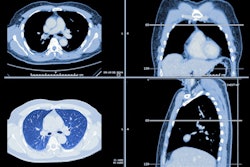
VIENNA - Adoption of radiology artificial intelligence (AI) software has increased substantially in the Netherlands over the last few years, and many sites are now utilizing multiple algorithms in clinical practice, according to research presented on 13 July at ECR 2022.
After surveying nearly 70 healthcare organizations in the Netherlands, a team of researchers from Radboud University Medical Center in Nijmegen found that at least one-third are using commercial AI algorithms for radiology applications in 2022.
 Kicky van Leeuwen.
Kicky van Leeuwen."We can see that adoption is stabilizing," said presenter Kicky van Leeuwen, a doctoral candidate.
Many radiology AI products are now commercially available in Europe for clinical practice. To ascertain implementation trends, the researchers surveyed radiology departments at 69 healthcare organizations in the Netherlands for the third straight year in the Spring. The organizations were asked questions relating to their clinical use of CE-marked AI products for radiology, their available funding for AI, and the biggest obstacles to implementation.
In the most recent survey, the researchers also asked if the organizations had discontinued the use of any AI software products. They received 44 responses to the 2020 survey, 37 responses to the 2021 survey, and 29 responses to the 2022 survey.
| Increase in radiology AI adoption in the Netherlands | |||
| 2020 | 2021 | 2022 | |
| Organizations using AI in clinical practice | 14 | 23 | 24 |
| Total number of AI implementations in clinical practice | 19 | 49 | 74 |
| Number of unique AI products used in clinical practice | 8 | 39 | 46 |
| Institutions with budgets allocated for AI implementation at either departmental or institutional level | 26% | 35% | 36% |
"There are now organizations out there that may have four or five products in clinical practice," she said.
Also, a total of seven products were no longer used by healthcare organizations, van Leeuwen said.
The most popular AI use cases included bone age prediction (9 sites), lung nodule detection on CT (8 sites), and stroke -- left ventricle occlusion (LVO) or intracranial hemorrhage detection on CT and CT angiography (8 sites).
In other survey results, three radiology departments have adopted an AI platform/marketplace, according to van Leeuwen.
The respondents cited costs or lack of budget as the biggest obstacle for AI purchase, validation, or implementation. IT and integration was the second biggest obstacle, followed by the lack of validation; an unclear business case; and the lack of vision, policy, or ownership.
When asked their opinion on the benefits of clinical use of AI, 33% believed that it yielded increased health and reduced costs, while 29% said it led to increased health. A further 29% reported an unclear benefit and the remaining 9% felt it had no benefit.


















